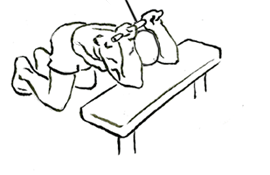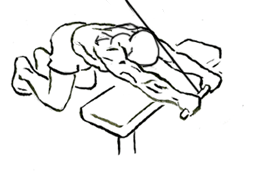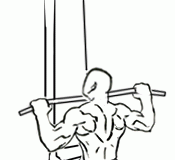Last Updated on September 26, 2014
The kneeling triceps extension with cable is a focused, isolation exercise designed to maximize triceps engagement. By kneeling, you limit the involvement of other muscle groups, allowing you to concentrate solely on the triceps. This exercise, which uses a cable machine for consistent resistance, is an excellent addition to your arm workout routine if you aim to build strength, size, and definition in your triceps.
In this detailed guide, we’ll explore the benefits of the kneeling triceps extension, provide step-by-step instructions for proper technique, discuss variations and tips for avoiding common mistakes, and highlight how to integrate this exercise into your workout regimen.
What is the Kneeling Triceps Extension with Cable?
The kneeling triceps extension with cable is an upper-body isolation exercise that targets the triceps brachii, the primary muscle responsible for extending the elbow joint. By kneeling in front of a cable pulley machine, you create a stable position that isolates the triceps while minimizing the activation of other muscles like the shoulders or back. This ensures that the triceps are fully engaged throughout the movement.
Muscles Worked During the Kneeling Triceps Extension
The primary muscle group activated is:
- Triceps Brachii: The main focus of the exercise is the triceps, particularly the long head, which helps extend the arm and stabilize the shoulder joint during overhead movements.
Secondary muscles involved include:
- Forearms: As you grip the cable bar and maintain control, the forearms are engaged, improving grip strength.
- Core Muscles: The kneeling position and the movement of the cable bar require core stabilization, engaging the abdominals and obliques to maintain proper posture.
- Upper Back and Shoulders: While these muscles are not the primary focus, they work as stabilizers to help maintain form throughout the exercise.
How to Perform the Kneeling Triceps Extension with Cable: Step-by-Step Guide
Executing this exercise with proper form is essential for maximizing its effectiveness and reducing the risk of injury. Follow these steps:
- Set Up the Equipment:
- Attach a straight bar to the high pulley of the cable machine. Adjust the pulley so it is positioned above your head when you kneel.
- Place a bench sideways in front of the cable machine. The bench will serve as a guide for the motion and help you maintain stability.
- Assume the Kneeling Position:
- Kneel on the floor in front of the bench, with your back straight and your head slightly down.
- Grasp the straight bar with an overhand grip (palms facing down). Your arms should be overhead, and your elbows should be positioned above your head. Ensure your forearms are aligned and ready for the movement.
- Execute the Movement:
- Keeping your elbows close to your head, push the cable bar down in an arcing motion. Lower the bar until your forearms touch or come close to the bench. This action fully engages the triceps and allows for a deep contraction.
- Maintain a slow and controlled motion, ensuring your triceps are doing the work. Avoid using momentum or swinging the bar.
- Return to the Starting Position:
- Slowly reverse the movement, returning your arms to the starting position with the elbows above your head. Ensure you maintain control of the bar throughout the movement, avoiding any rapid or jerky motions.
- Repeat for the desired number of repetitions, focusing on form and muscle engagement.
Tips for Proper Form
To optimize the effectiveness of the kneeling triceps extension and prevent injury, keep these tips in mind:
- Engage Your Core: Tightening your core muscles stabilizes your torso, helping maintain a straight back and proper posture throughout the exercise.
- Keep Your Elbows Close: Ensure your elbows remain close to your head and do not flare out. This isolates the triceps more effectively and prevents the shoulders from taking over the movement.
- Use a Light to Moderate Weight: Start with a manageable weight to ensure you can control the movement and maintain form. Gradually increase the weight as your strength improves.
- Move Slowly and Deliberately: Focus on the triceps contraction throughout the movement, avoiding the use of momentum. Slow, controlled reps are more effective for building strength and muscle definition.
Benefits of the Kneeling Triceps Extension with Cable
- Isolated Triceps Engagement: By kneeling, you stabilize your body and isolate the triceps, ensuring that they do the majority of the work during the movement.
- Consistent Resistance: The use of a cable machine provides constant tension throughout the exercise, which is beneficial for muscle growth and building endurance in the triceps.
- Improves Arm Definition: The isolation and controlled motion of this exercise make it particularly effective for sculpting and defining the triceps, which contribute to overall arm aesthetics.
- Enhances Core Stability: The kneeling position requires balance and core activation, providing an additional benefit by strengthening the abdominals and improving posture.
- Versatility: This exercise is adaptable, allowing you to increase or decrease resistance easily by adjusting the weight on the cable machine. This makes it suitable for all fitness levels.
Variations of the Kneeling Triceps Extension
To keep your workout routine fresh and to challenge your triceps in different ways, try incorporating these variations:
1. Standing Overhead Triceps Extension with Cable
If you prefer not to kneel, performing the exercise while standing offers a similar triceps isolation but engages the legs for stability.
- How to Perform: Stand with your feet shoulder-width apart, facing the cable machine. Grasp the cable bar with an overhand grip and extend your arms overhead. Perform the extension, focusing on keeping your elbows close to your ears.
2. Single-Arm Kneeling Triceps Extension
For an added challenge and to correct any muscle imbalances, try the single-arm version of the exercise.
- How to Perform: Attach a single handle to the cable and perform the exercise one arm at a time. This variation engages the core further as you work to maintain balance while focusing on one side at a time.
3. Seated Overhead Triceps Extension
This variation provides additional back support, making it ideal for those who may struggle with balance or want to focus purely on the triceps without core engagement.
- How to Perform: Sit on a bench with your feet flat on the floor. Grasp the cable bar with an overhand grip, and perform the extension with your back supported. This position allows for heavier loads since stability is increased.
Common Mistakes to Avoid
Even though the kneeling triceps extension with cable is an isolation exercise, improper form can reduce its effectiveness or lead to injury. Here are some common mistakes and how to avoid them:
- Flaring the Elbows Out: When the elbows move away from the head, the shoulders become involved, reducing triceps engagement. Keep your elbows close to your ears to maintain proper isolation.
- Arching the Back: This usually happens when the weight is too heavy. Focus on engaging your core and keeping your back straight to prevent strain.
- Using Too Much Weight: Lifting a weight that is too heavy can lead to improper form and reduced triceps activation. Start with a manageable weight and focus on controlled movements before increasing the load.
- Rushing Through the Movement: Performing the exercise too quickly reduces the time under tension, which is crucial for muscle growth. Slow, controlled reps ensure maximum muscle engagement and reduce the risk of injury.
Programming the Kneeling Triceps Extension with Cable into Your Routine
The kneeling triceps extension can be integrated into your workout routine in various ways:
- Arm Day Routine: Include 3-4 sets of 12-15 repetitions during your arm workout to target the triceps directly.
- Upper Body Circuit: Incorporate this exercise into a circuit with other upper body movements like bicep curls, shoulder presses, and push-ups for a balanced session.
- Finisher Exercise: Use the kneeling triceps extension as a finisher to fully fatigue the triceps after performing compound movements like bench presses or dips.
FAQs About the Kneeling Triceps Extension with Cable
Q1: Can beginners perform this exercise?
Yes, beginners can perform the kneeling triceps extension, but it’s important to start with a light weight to focus on mastering the technique. As you gain confidence and strength, you can gradually increase the resistance.
Q2: How often should I perform this exercise?
For optimal results, include this exercise in your workout routine 2-3 times per week, ensuring at least one day of rest in between sessions for muscle recovery.
Q3: Are cables better for triceps isolation than dumbbells?
Cables offer the advantage of constant tension throughout the movement, which can be more effective for isolating the triceps compared to dumbbells, especially when aiming for muscle growth and definition.
The kneeling triceps extension with cable is an effective exercise for isolating and building triceps strength. By focusing on proper form, maintaining a controlled pace, and integrating it strategically into your routine, you can maximize its benefits and see significant improvements in arm definition and strength.
Whether you’re a beginner looking to build foundational strength or an advanced lifter aiming to refine muscle detail, this exercise provides the targeted engagement needed to develop your triceps efficiently.
Note: Keep your abs drawn in and your back straight as you perform this exercise.


Exercise images by Everkinetic.






